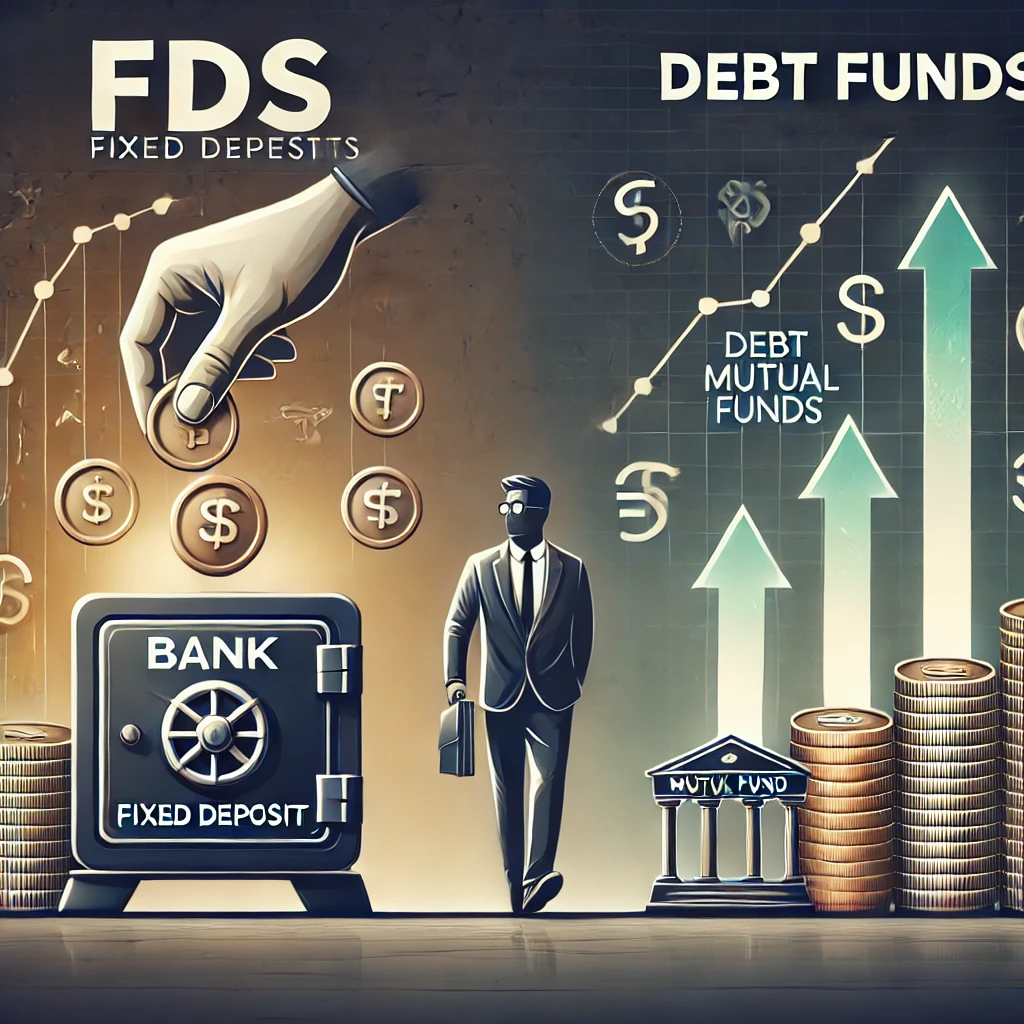Investors often face a dilemma when choosing between Fixed Deposits (FDs) and Debt Funds for parking their savings. Both are considered relatively safe investment options but differ in terms of returns, risk, liquidity, and taxation. This article provides a detailed comparison to help you make an informed decision.
What is a Fixed Deposit (FD)?
A Fixed Deposit is a financial instrument offered by banks and financial institutions where you invest a lump sum for a fixed period at a predetermined interest rate. It is considered one of the safest investment options.
Key Features of Fixed Deposits:
- Guaranteed returns with a fixed interest rate.
- Investment tenure ranges from 7 days to 10 years.
- Premature withdrawals are allowed with a penalty.
- Interest is taxable under ‘Income from Other Sources’.
- Suitable for conservative investors seeking stable returns.
What is a Debt Fund?
A Debt Fund is a type of mutual fund that invests in fixed-income securities such as government bonds, corporate bonds, treasury bills, and other money market instruments. It aims to generate steady income while maintaining lower risk than equity funds.
Key Features of Debt Funds:
- Market-linked returns that vary with interest rate movements.
- More liquidity compared to FDs; can be withdrawn anytime.
- Tax-efficient if held for over three years (eligible for indexation benefits).
- Suitable for investors looking for short to medium-term investment options.
Types of Debt Funds
- Liquid Funds – Invest in short-term debt instruments with a maturity of up to 91 days. Ideal for parking surplus cash.
- Ultra-Short Duration Funds – Invest in securities with maturities between 3 to 6 months, offering better returns than savings accounts.
- Short-Term Funds – Invest in bonds with a duration of 1 to 3 years. Suitable for investors looking for moderate risk with stable returns.
- Corporate Bond Funds – Invest primarily in high-rated corporate bonds, offering slightly higher returns.
- Gilt Funds – Invest in government securities with no credit risk but are subject to interest rate risk.
- Dynamic Bond Funds – Fund managers actively adjust the portfolio based on interest rate movements.
- Credit Risk Funds – Invest in lower-rated bonds with the potential for higher returns.
Comparison: Fixed Deposit vs. Debt Fund
| Feature | Fixed Deposit | Debt Fund |
|---|---|---|
| Returns | Fixed | Market-linked |
| Risk Level | Low | Moderate |
| Liquidity | Lock-in period; early withdrawal penalty | High, can be withdrawn anytime |
| Taxation | Interest taxed as per income tax slab | LTCG (20% with indexation) if held for >3 years |
| Best For | Conservative investors | Investors seeking better returns with moderate risk |
Which One Should You Choose?
- If you seek stable and predictable returns with zero risk, opt for Fixed Deposits.
- If you want liquidity, tax benefits, and higher returns, opt for Debt Funds.
- For short-term savings (less than 1 year), Liquid Funds or Ultra-Short Duration Funds can be a good alternative to FDs.
- For long-term tax efficiency, Debt Funds with indexation benefits are preferable.
Final Thoughts
Both Fixed Deposits and Debt Funds have their advantages and disadvantages. The choice depends on your risk appetite, investment horizon, and financial goals. Conservative investors can stick with FDs, while those seeking higher but relatively stable returns with tax efficiency may prefer Debt Funds.
Disclaimer: This article is for informational purposes only and does not constitute financial advice. Please consult a financial advisor before making investment decisions.
